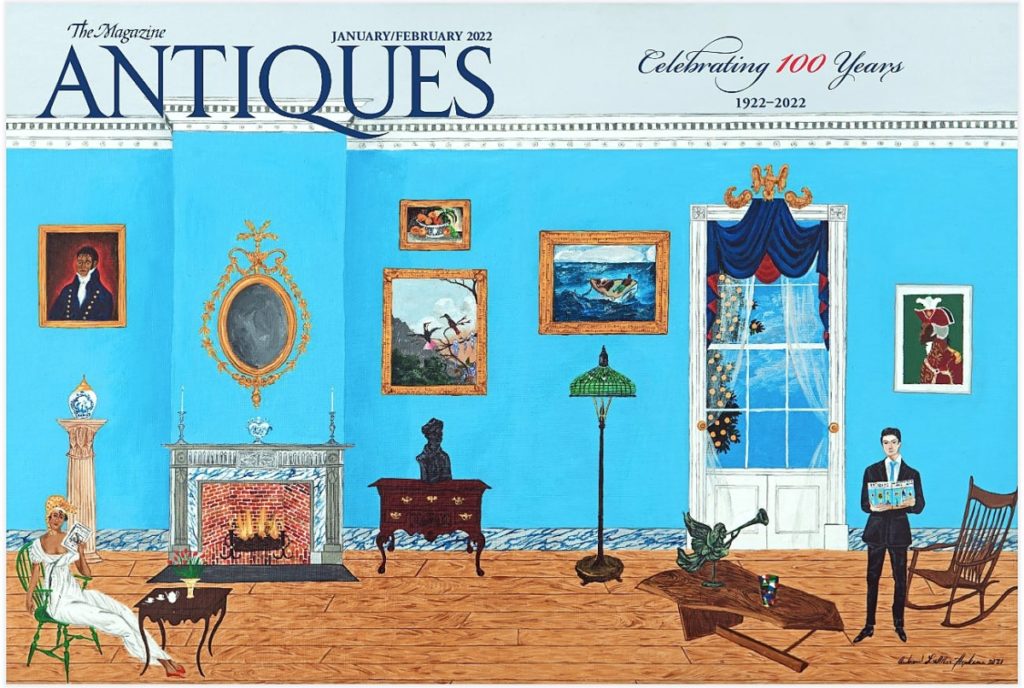
The January/February 2022 cover of the anniversary issue featured “The Magazine Antiques: The First One Hundred Years” by Andrew Lamar Hopkins. Photo by Alister Alexander/Camerarts, N.Y. courtesy of the artist.
By Madelia Hickman Ring
NEWTOWN, CONN. – On November 12, when the Antiques Dealers Association of America (ADA) awards its 21st annual Award of Merit to The Magazine Antiques (TMA), it will be the second time in the indispensable publication’s 100-year history to be recognized for its contributions to the industry, the first time being in 2004 when the ADA honored its then-editor, the late Wendell Garrett (1929-2012).
It is impossible to understate the importance the periodical has had to the fields of American decorative arts, architecture and antiques, tracing its roots to a nascent time when interest in American history and its material culture were on the rise. Scholars, collectors, dealers, curators, decorators, auction house experts and even enthusiasts can all find something of significance, whether in the seminal research in its black and white pages, or the most up-to-date scholarship in full color.
When the award’s recipient was announced over the summer, ADA board of directors’ member, Arthur Liverant, summed it up succinctly: “As The Magazine Antiques celebrates its centennial anniversary in 2022, it is wholly appropriate to give them the ADA’s Award of Merit. For 100 years, the magazine has been a partner in the arts field along with a lot of terrific authors who have written timely articles. It has been a place for dealers to advertise their wares and findings and it has been a major part of the success of our industry.”
Accepting the award when it is presented during the Delaware Antiques Show in Wilmington, Del., will be TMA’s co-owners, publisher Don Sparacin and Gregory Cerio, who is just the sixth person to inherit the editor’s desk since it was occupied first by Homer Eaton Keyes from 1922 to 1939. Successors followed through the decades with Alice Winchester (1939-1972), Garret (1972-1990), Alison Ledes (1990-2007) and Elizabeth “Betsy” Pochoda (2007-2016), who remains on TMA‘s staff as advisory editor.

Gregory Cerio, editor of The Magazine Antiques.
Sparacin first came to the publication as a sales rep in 2011 after a 15-year career with two American Art galleries that had been long-standing advertisers in TMA; he sees it as a natural progression to publisher in 2015. Cerio’s tenure began as the editor in 2016 following editorial roles at Modern Magazine and House & Garden. Both Sparacin and Cerio weathered the tumultuous transitions the magazine experienced when it – along with Art in America, Modern and ARTnews – were acquired in the spring of 2016 by Art Media Holdings, which was owned by publishing magnate, Peter Brant. Then, in the fall of 2018, the company changed hands again when all of Brant’s Art Media Holdings were purchased by Penske Media Corporation, which owns, among other publications, Rolling Stone, Variety and the Robb Report. A few months later, in April 2019, Cerio and Sparacin announced they had acquired TMA.
The freedom of independent ownership, at the cost of increased challenges and responsibility, is one both co-owners embrace wholeheartedly while striving to maintain its reputation and respected voice in the field. Cerio brings an attitude that more broadly expands the definition of “antiques” as works of art from the past – sometimes the near past – that tell stories, about people, places and habits of mind. He is keen to feature stories that reexamine the past and uncover new insights, even if it means questioning established historical narratives.
“My priority is to leave it better than I found it,” Sparacin says. “TMA is an institution, a pillar supporting something far bigger than myself. It is revered and deserves careful management to see it through the next hundred years.”
The periodical retains several key aspects that have been its mainstays over its 100-year history: depth of scholarship and breadth of subject matter being two of its most crucial hallmarks. Cerio credits Eleanor Gustafson, who has worked at TMA for 50 years, for helping to maintain the magazine’s high standards for accuracy and scholarship. “Eleanor has spent her entire working career at TMA, with 10 years as executive editor. She’s semi-retired, but as consulting editor she still helps us out enormously with scrupulous editing and proofreading, and still writes a column that appears on the final page of each issue,” Cerio says. “Eleanor is our keeper of the flame; our institutional memory. She keeps us all in line and makes our work better.”
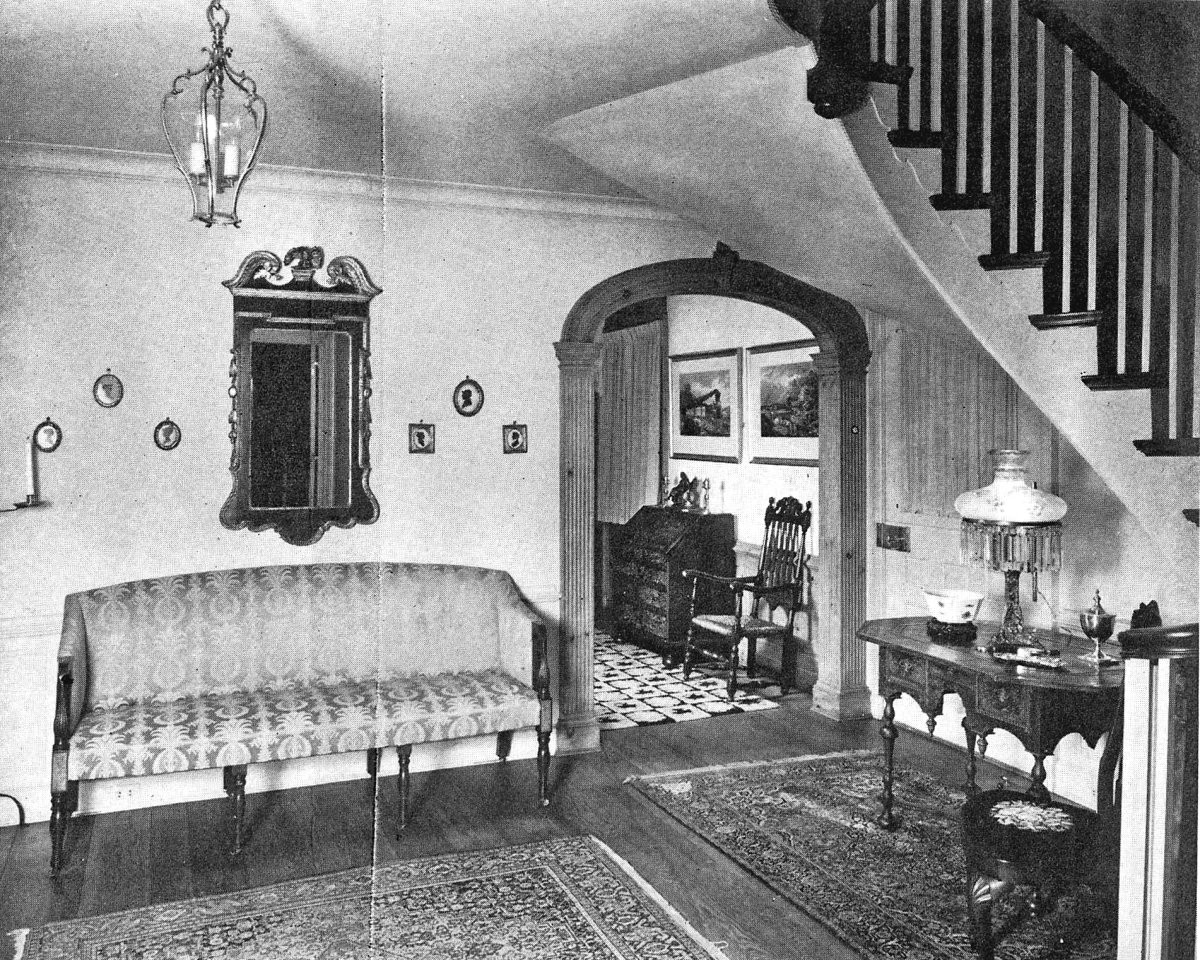
From its earliest days, how people interact with antiques has been a popular feature in TMA, one that began in January 1941 when then-editor Alice Winchester profiled the Fairfield, Conn., home of Mr and Mrs Charles K. Davis. At the time, the column was called “Antiques in Domestic Settings;” since July of 1943, the feature has been known by its current name, “Living with Antiques.”
Not to be left out, and critical for the continuity of the “look” of TMA, is art director Martin Minerva, who has been with the publication for more than 20 years and art director since 2016.
Maintaining – and growing – readership is a top priority and TMA’s staff includes twenty- and thirty-somethings who bring a fresh perspective to each issue. A previously overlooked audience now being courted is a rising younger generation of dealers who are attracted by the ecological sensibility of antiques and who seek out objects that are not necessarily finely made, use precious or expensive materials or have a fancy history. Rather, things that are unusual or unique have an appeal.
Refusing to believe that print media is dead, both Sparacin and Cerio nevertheless know that in this age of digital media, the periodical had to adapt. “We write to be read and take photos to have them seen, so you go where the eyes are,” Cerio sums up concisely.
To that end, TMA has embraced digital and social media to not only expand its reach but to engage new or young viewers who might view the periodical as a holdover to the era of grandparents or great-grandparents.
Among its expanded menu of digital offerings is a monthly podcast called Curious Objects, which was pitched to then-editor Betsy Pochoda in 2016 by Benjamin Miller, director of research at S.J. Shrubsole. The first podcast debuted in November 2017 with Michael Pashby titled Secret History of the Windsor Chair. Originally in the form of a one-on-one interview, the feature has recently undergone a makeover: the new format mixes in a range of voices and views, including reports from interviewers in the field. The new season of podcasts will be launched in early November.
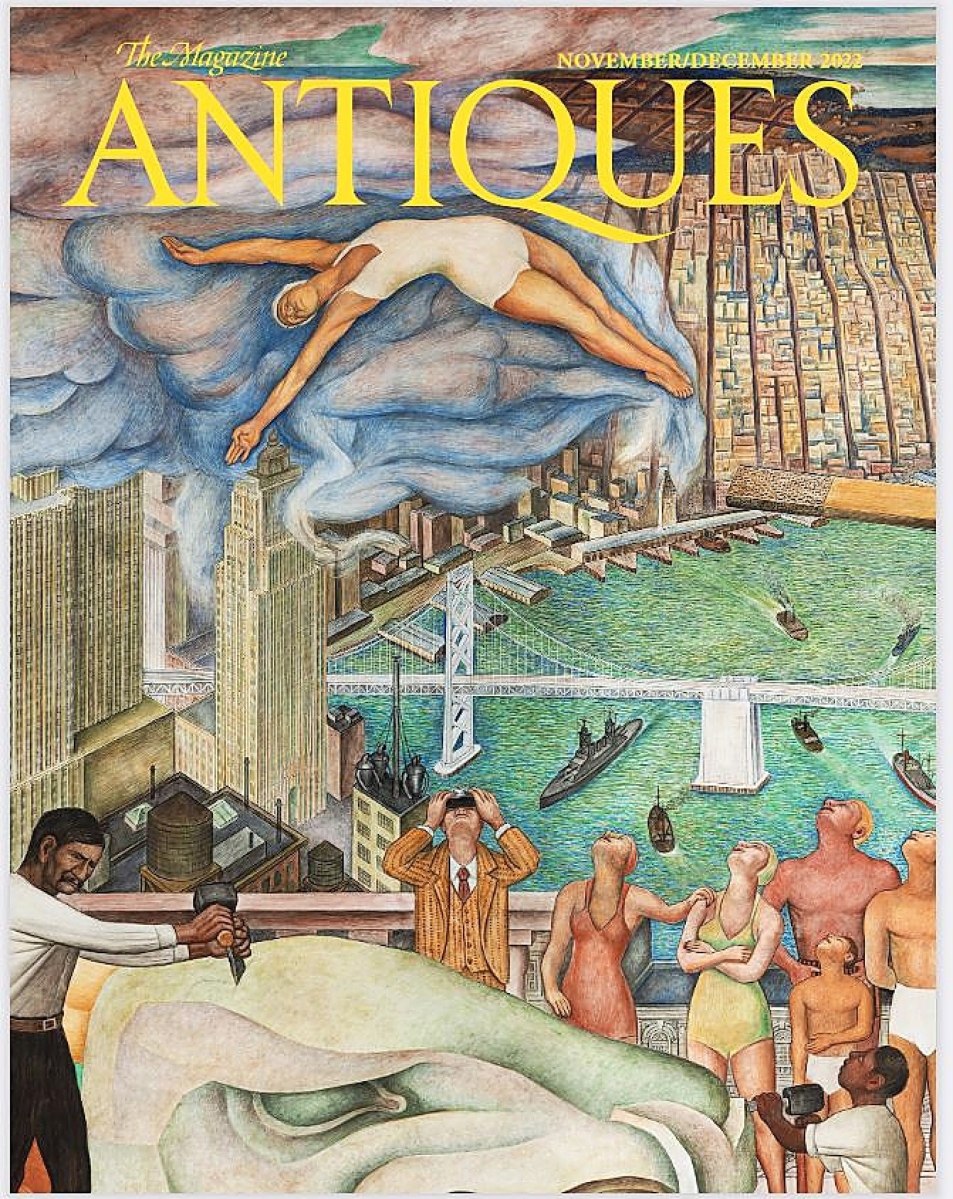
Since January 2022, The Magazine Antiques has produced 1,134 issues. This is the most recent cover, for its November/December 2022 issue.
Overseeing the podcasts is Sammy Dalati, who also joined TMA as a fact-checker in 2016, bringing to the publication a studio art degree from New York University. Dalati works closely with Miller, who knows figures in the field who would make subjects or have interesting objects in their collections. Topics are a collaboration among the team.
“We talk about what kind of angles to take, what sort of audience we want to reach. We have devoted listeners but anytime there is something new and digital by young people, there is some hesitation. We’ve gotten a good response from the podcasts from within the antiques world, but the question is always how to expand, how to incorporate different elements to make a more entertaining feature.
Another digital feature that Dalati – with guidance from Minerva – is responsible for, and which has seen great interest and widespread appeal are YouTube videos that explore a single topic or question in a fun and lively but insightful and scholarly way. Captioned “TMA Explains,” the short – about five minutes or less – combines Twenty-First Century digital storytelling with TMA‘s signature scholarship to address a single question in a variety of topics. Informative and fun, the channel has titles such as Lettuce Ware, Explained; The Lost Mural of 30 Rock; Why period films are suddenly SO colorful; and How Hoosier Cabinets ‘Saved’ the American Housewife. Interestingly, the most popular one at press time is one titled So Brutal!, which addresses why Brutalist architecture is the most polarizing style of architecture.
The monthly podcasts get about 2,000 listeners a month; a total of 28 have been made, all of which can be found on Spotify, Patreon, Soundcloud and Apple Podcasts. TMA‘s library of YouTube videos – of which 11 have been made – are accessible on TMA’s YouTube channel.
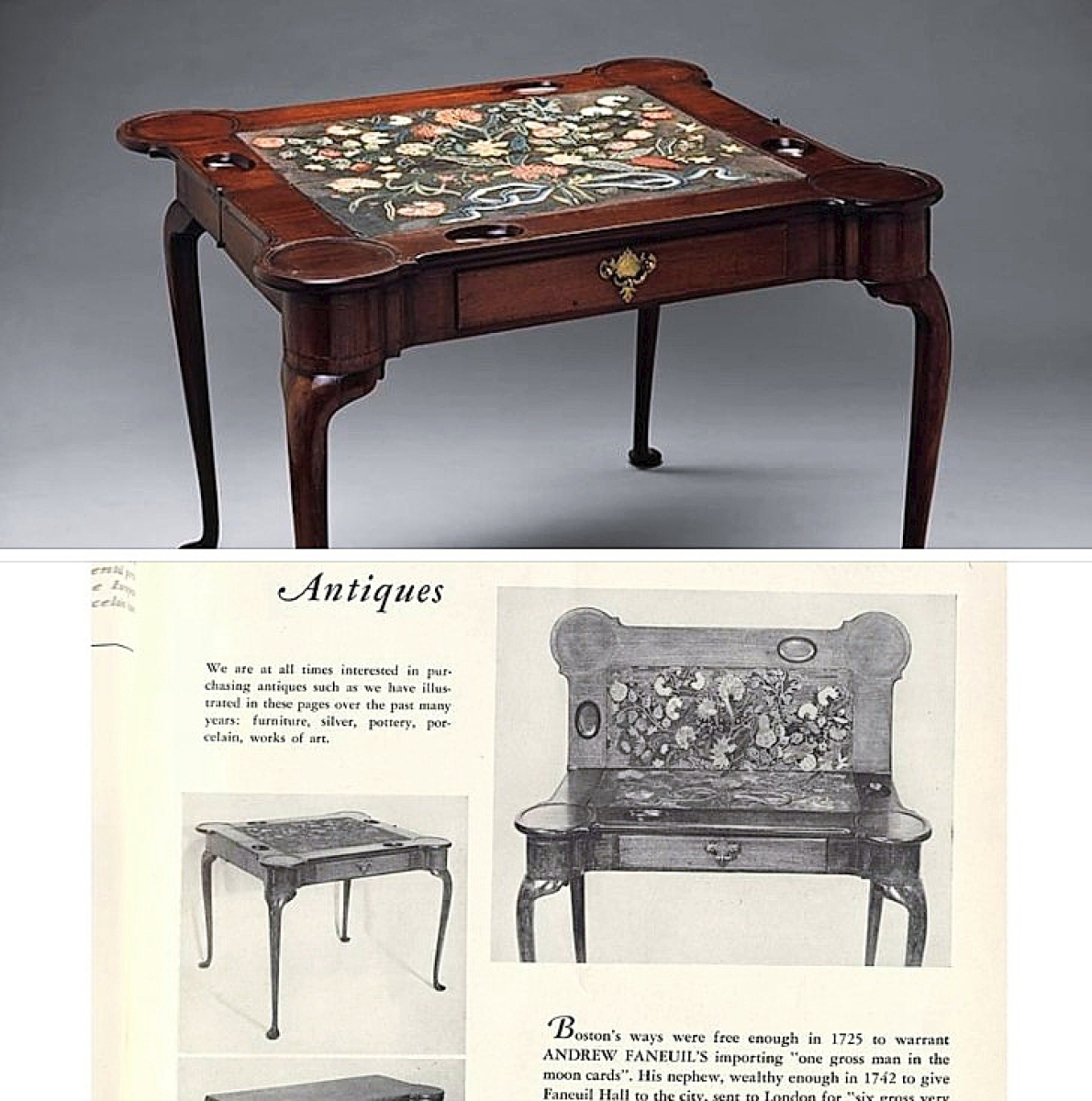
For the #AntiqueOfTheDay on October 5, 2022, The Magazine Antiques posted a renewed look at a circa 1735-45 Boston card table with needlework playing surface that had been advertised by Ginsburg and Levy in the August 1951 issue of The Magazine Antiques. The table was purchased by Ima Hogg in October 1951 and is now in the permanent collection at Bayou Bend, a gift of Ima Hogg. Clicking on the post — this one taken from Facebook — would have a full-size photo of both the table and the advertisement, as well as more information about the table.
The entirety of each print issue – which has been published bimonthly since 2010 – is available online to subscribers, as well as additional digital features. Two newsletters are delivered via email to about 16,000 subscribers: TMA Distilled comes out monthly and offers an encapsulated digest of the current print issue as well as some web-only original content. On a more frequent – and usually weekly – basis, Wandering Eye keeps readers up on current and crucial news on antiques and the fine arts that editors curate from online art news feeds.
“Wandering Eye is our most fun newsletter,” shared Sarah Bilotta, TMA’s digital manager. “Don Sparacin writes that and it’s usually funny and a little wry. We can put things in there that are popular culture that we normally wouldn’t dedicate a whole article to. We get a lot of positive feedback on it from our readers.”
For those who need a more regular – even daily – antiques fix, Bilotta has that covered, too, a task she assumed from Glenn Adamson, currently a contributing editor for TMA.
“While we’re a bimonthly publication, what’s great about having a web presence is that we can put content out as its breaking, which is more and more important to our young readers. They’ll go to sources that have the timeliest content that is about what is going on in the world as it’s connected with antiques and fine art.” Case in point: one need not look any further than a tweet she issued on September 8, the day of Queen Elizabeth’s passing; it featured a cover prior to her coronation in 1953 which featured articles on the Royal Collection.
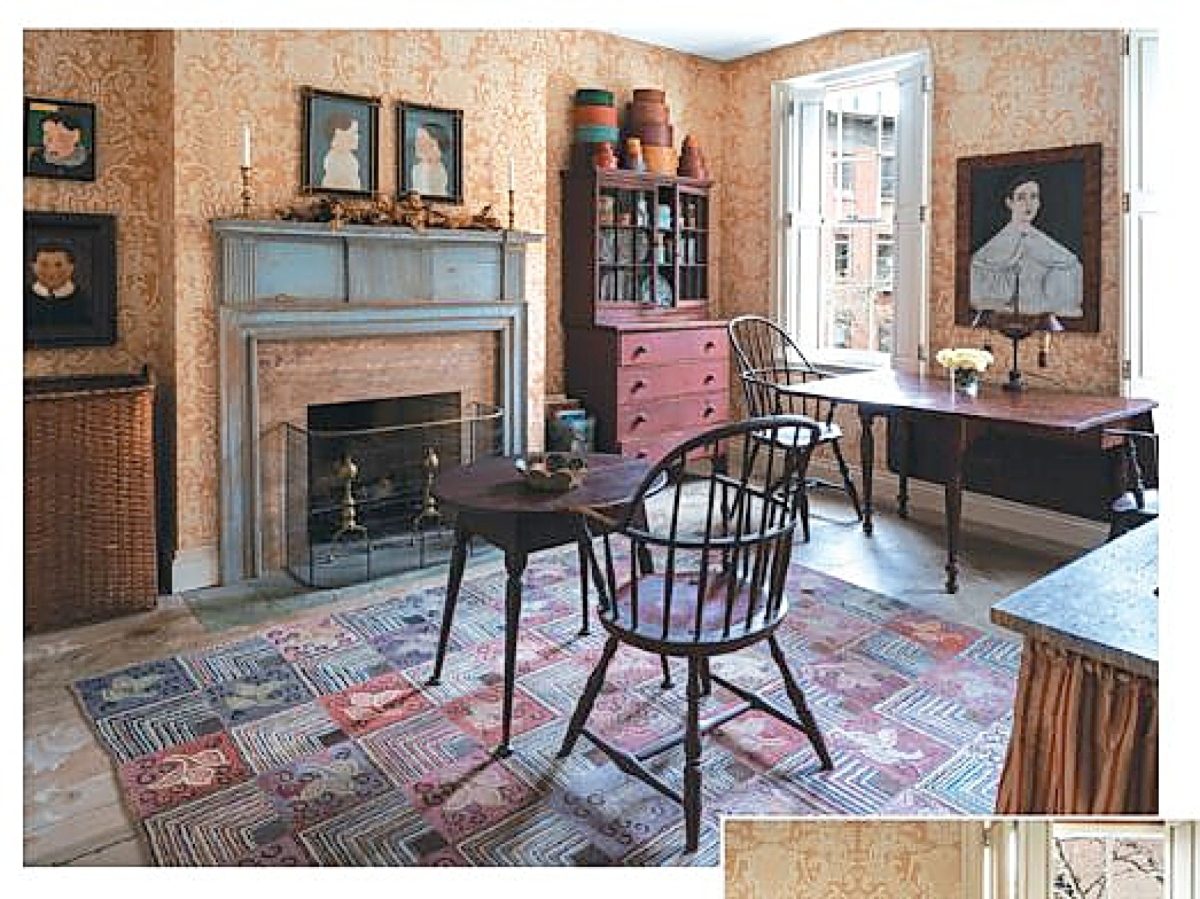
The most popular feature of The Magazine Antiques is one of its longest-running ones, “Living with Antiques”; it is, largely, a format that has not changed much in its more than 80 years. In the July/August 2022 issue, Stacy C. Hollander explores the home of Marc Brown, who created the children’s literary hero Arthur, and the home he shares with his wife and artist, Laurene Krasny Brown. Shown here is the upstairs sitting room in the Browns’ Greenwich Village home. Photography by Ellen McDermott with Bridget Sciales.
To stay current, TMA‘s social media presence on Facebook (https://www.facebook.com/TheMagazineAntiques/), Twitter (https://twitter.com/AntiquesMag) and Instagram (https://www.instagram.com/antiquesmag/) is updated with several regular features for unique followers which, at press time, numbered about 30,000.
“We have 100 years of content to choose from, we use it to our advantage,” says Bilotta, who relies on TMA‘s entire publication run for inspiration. All features are shared on all three social media platforms, which has grown several-fold since Bilotta came on board a year ago.
“Antique of the Day” (#AntiqueOfTheDay) often looks at a particular item that was previously featured and revisits it, highlights something unusual or interesting coming up for sale at auction or explores an item in a museum collection. Doing these 365 days a year, the post does not shy away from featuring an item related to holidays or noteworthy current events.
“There is such a fantastic history of graphic design for TMA‘s covers,” notes Bilotta, who is also currently a graduate student of design history at the University of Oxford. For her Instagram “Throwback Thursday,” (#ThrowbackThursday) posts, Bilotta features a cover from a previous issue, often featuring the work of Milton Glover, who was TMA‘s consulting artist beginning with the August 1948 issue; ultimately becoming art director, his tenure extended until 1973, when he retired.
“Everyone loves to see how other people live,” Alice Winchester wrote in 1950, explaining the popularity of featuring private collections that remains to this day one of the periodical’s most beloved features. When Winchester penned her first feature – a two-part spread exploring the Fairfield, Conn., home of Mr and Mrs Charles K. Davis in January and March 1941, it had the initial title, “Antiques in Domestic Settings.” Two years later, in the March 1943 issue, the feature was recaptioned “Antiques in American Homes” but by July of that year, Winchester settled on the name that has finally stuck: “Living with Antiques.”
Not only is “Living with Antiques” still a regular feature, but in the summer of 2022, Bilotta introduced – for digital voyeurs – “Friday Features.” Showing a single image of a beautiful interior, the weekly post complements the lengthy interior spreads that continue to document the homes and other personal spaces of collectors and connoisseurs throughout the field.

Thumbnail from a TMA Explains YouTube video, “Brutalism is the most polarizing style EVER — here’s why.” To date, it is the YouTube video that has earned the most views — 6,662 at press time.
When asked about the demographics of digital viewers, Bilotta notes that they fluctuate as she changes up their content, but neither she nor Sparacin leave it up to chance. Rather, she sets quarterly goals that they reevaluate regularly. “Our main imperative is to gain followers who will get something out of what we offer, and who will potentially be subscribers.”
What does the future have in store for TMA? Both Cerio and Sparacin shared big-picture initiatives they’d love to see come to fruition. Planning is back in the works for single- or two-day tours of private collections or historic sites that were derailed because of the pandemic.
“Cocktails with a Connoisseur” is the working title for evening events at museums and galleries that would be geared towards a younger audience. In the near future, readers may be able to attend regular art and antiques symposium or lecture series presented by TMA. There has even been talk about sponsoring its own award. Other changes that have been germinating with Sparacin and Cerio are thematic issues, as well as publishing a book featuring some of the greatest hits of TMA‘s first 100 years.
All of TMA’s content was digitally scanned in 2019 but not all of it is on a platform to serve it. TMA‘s editorial assistant, Elizabeth “Libby” Lanza has taken on the herculean task of adapting all the images going back to 2009, the earliest years that the articles are formatted for the web. Sparacin wants to go further, saying, “Scholars, dealers and enthusiasts want an indexed and searchable platform to enjoy the contents of our archive. We’re working hard to make that a reality.” He does not anticipate that being available until 2024.
Despite forward-facing thoughts, Cerio is aware of the magnitude of the present moment and does not hold back in his appreciation of the award. “Just look at the company we keep as a recipient: some of the greatest arts scholars, dealers and collectors of recent generations. The award recognizes not only the work of our current staff, but all the editors, writers, art directors, researchers and publishers of our past. More than that, this is an accolade shared by everyone in the community of interest involved with the fine and decorative arts.”



















